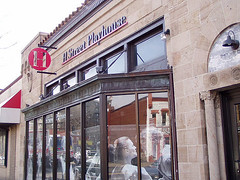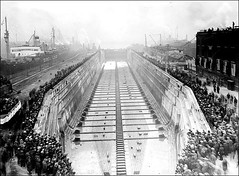Paving History--Brooklyn, Redevelopment, and Ikea
The revitalization of Red Hook is an ongoing story. I've written about it once, in the reprint of a letter by Jane Jacobs on the topic.
City Limits, the great publication from NYC (a model for something I'd like to do in DC) has an article about a more ground-up approach led by the first-in developer, see "OUTSIDE THE BOX: Developer Greg O’Connell seeks balanced building for Red Hook."
 H Street Playhouse opened in 2002. Photo by Elise Bernard. The H Street Playhouse is the example of first mover-innovator revitalization.
H Street Playhouse opened in 2002. Photo by Elise Bernard. The H Street Playhouse is the example of first mover-innovator revitalization.Greg O'Connell is comparable to people like the Robeys at the H Street Playhouse and David Bernhardt of Luna Laundromat on H Street -- see pages 52 and 53 from the October 2004 issue of the Voice of the Hill for something I wrote about this earlier -- technically, people like Jim Abdo--conversion of Children's Museum into housing and the Atlas Performing Arts Center are second stage entrants, so might be Joe Englert...
A week or two ago, I put up a blog link under the main section of links to the site BigCitiesBigBoxes, which mostly focuses on the battles in Red Hook. While poking around the New York Times website, I came across this article today, which discusses the proposal to replace a Red Hook pier, active beginning since the Civil War, with a parking lot for Ikea.
 Great ships once sat high and dry in Graving Dock No. 1, now poised to become a parking lot. Photo: Brooklyn Historical Society, about 1930.
Great ships once sat high and dry in Graving Dock No. 1, now poised to become a parking lot. Photo: Brooklyn Historical Society, about 1930.From the article, "Sailing into History":
EVEN though it is big enough to contain a battleship, Graving Dock No. 1 has long been one of Brooklyn's best-kept secrets. If you drive down Beard Street in Red Hook, all you see is a line of old brick warehouses. But on the other side, hidden away on the waterfront, lies a 710-foot-long concrete and steel basin originally dug out at the end of the Civil War.
Though the dock is on the site of the defunct Todd Shipyards, it is far more than just a historical curiosity. The dock has been an essential part of New York Harbor for 139 years. Ships floated in, a gate was closed, and the water was pumped out, leaving the hulls dry for painting or repair. (Some say the name refers to the resemblance to a grave; others point to the French word "grève," for a flat sandy beach where ships would have been worked on before dry docks were developed.)
The dock has seen boom times when thousands of longshoremen, shipbuilders and sailors roamed the Red Hook streets, and the neighborhood was full of theaters, markets, clothing stores and bars. And it has seen bad times. During the 1960's, much of the harbor's shipping moved to New Jersey. Hundreds of local workers lost their jobs, many businesses closed and the population dwindled. In the 70's and 80's, drugs and crime further battered a reeling neighborhood. Yet the dock lived on. For the past eight years it was operated by Stevens Technical Services, a company that kept hundreds of skilled maritime workers paid.
Hard times couldn't kill the graving dock, but now prosperity might finally lay it to rest. The old survivor was closed in February, after Stevens's last lease expired. The Swedish home furnishings chain Ikea, which hopes to open a megastore on the waterfront in 2007, plans to fill in most of the dock and build a parking lot. ...
Conversion of industrial properties for retail, housing, and related services is an issue across the country, in cities from Baltimore to San Francisco. But eliminating the industrial businesses also eliminates the jobs and contributes to unemployment and neighborhood destabilization.



0 Comments:
Post a Comment
<< Home